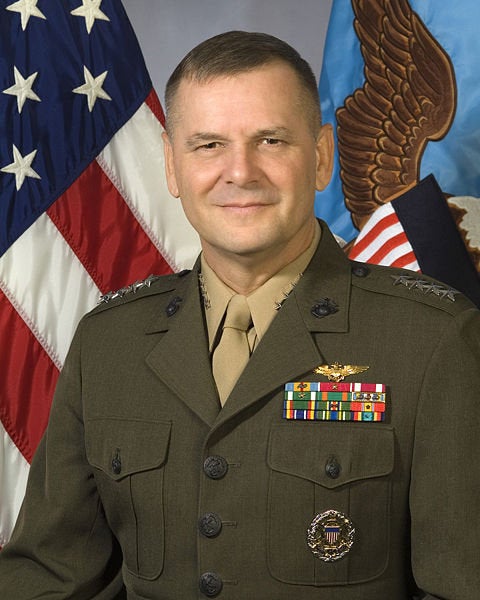
WASHINGTON -- A blue ribbon commission headed by a former commander of U.S. nuclear forces Tuesday called for an end to "Cold War thinking" and a sharp reduction in America's arsenal of nuclear weapons to better fit security threats in the 21st century.
A report by the Global Zero U.S. Nuclear Policy Commission, headed by former vice chairman of the Joint Chiefs of Staff James "Hoss" Cartwright, urged "an urgent and transformational change in U.S. nuclear force structure, strategy and posture" over the next 10 years. It recommended reducing the U.S. nuclear arsenal to 900 warheads from nearly 5,000 currently, a reduction it said would cut spending on nuclear weapons programs by as much as $100 billion over the next decade.
"The strategy inherited from the Cold War, which remains in place, artificially sustains nuclear stockpiles that are much larger than required for deterrence today," the report said. "The actual existing threats to our two countries (and the globe) cannot be resolved by using our nuclear arsenals. No sensible argument has been put forward for using nuclear weapons to solve any of the major 21st century problems we face -– threats posed by rogue states, failed states, proliferation, regional conflicts, terrorism, cyber warfare, organized crime, drug trafficking, conflict-driven mass migration of refugees, epidemics or climate change. A large standing Cold War-like nuclear arsenal cannot productively address any of these dangers."
The expert panel, brought together by the international arms-control advocacy group Global Zero, included former Republican senator Chuck Hagel, former chief START negotiator Richard Burt, former U.S. ambassador to the United Nations Thomas Pickering and former Supreme Allied Commander Atlantic for NATO, retired Gen. Jack Sheehan.
Their blueprint comes as President Barack Obama weighs options to shrink the number of nuclear weapons under the New START treaty with Russia that was ratified by the Senate in December 2010. Under the agreement, each country would be limited to 1,550 strategic nuclear warheads and 800 delivery vehicles.
But there is nothing stopping the Pentagon or the Kremlin from going lower and the Cartwright group lays out in its 26-page report how the two largest nuclear powers could disarm even further. The experts call for renewed arms negotiations with Russia that would reduce the U.S. arsenal to 900 total strategic nuclear weapons on modified alert, with half deployed and half kept in reserve. Instead of the current hair-trigger system that provides leaders just minutes to decide whether to launch or respond to an attack, the deployed warheads would be "de-alerted" to require from 24 hours to 72 hours to ready missiles for launch.
The panel of military and diplomatic experts urged the elimination of all U.S. tactical nuclear weapons over the next 10 years. "Their military utility is practically nil," the report said.
As for hostile countries that possess or are pursuing nuclear weapons, namely Iran and North Korea, "vigilant missile defenses and conventional forces kept on constant alert" are the answer, according to the report.
But Russia, as well as China, "are not enemies of the United States," the report stated. It noted that Russia wasn't included in a recent survey of policy experts as being among the top 20 contingencies directly threatening the U.S. homeland -- despite Mitt Romney's insistence that it is "our number one geopolitical foe." The Republican candidate, who has promised to increase defense spending, not cut it, has said he would review the implementation of New START if elected president.
While the report maintained that, "mutual assured destruction no longer occupies a central psychological or political space in the U.S.-Russian relationship," there may be more fundamental barriers to turning the recommendations into reality: politics.
In keeping with its post-Cold War theme, the experts recommended eliminating land-based intercontinental ballistic missiles (ICBMs), part of the traditional nuclear triad that includes submarines and bombers. "ICBMs in fixed silos are inherently targetable," the report said. Because they must be fired within minutes to avoid being destroyed by incoming enemy missiles, their "rapid reaction posture … runs a real risk of accidental or mistaken launch," it said.
The report called for a two-pronged nuclear defense instead, made up of 10 Trident ballistic missile submarines armed with 720 strategic missile warheads (360 deployed, 360 reserve) and 18 B-2 bombers armed with 180 gravity bombs (90 deployed, 90 reserve). Plans for upgraded ICBMs would be scrapped. All existing silo-based ICBMs in North Dakota, Montana and Wyoming would be dismantled or converted to conventional munitions.
Good luck with that. As reported by The Huffington Post last month, members of Congress from rural states that are home to America's land-based nuclear arsenal are likely to go ballistic at any efforts to uproot the missiles in their midst.